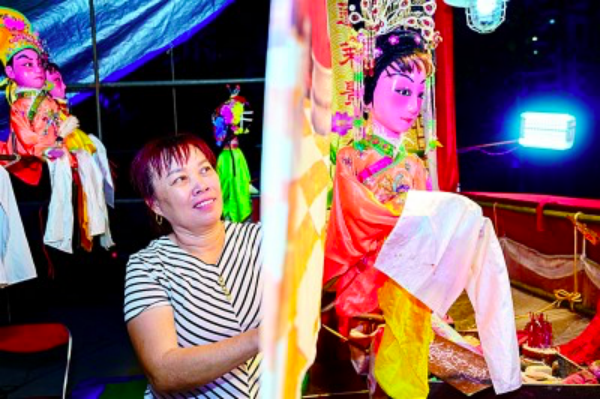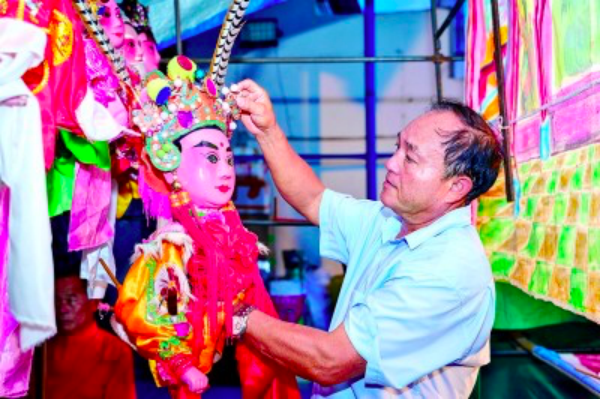The Puppets of Sanjiang
Recently, Haikou’s Beigang Island staged a traditional Sanjiang Puppet Show. Accompanied by the graceful and melodious strains of Bayin—the eight piece ensemble—the voices of the Dazhipo Liangyan Puppet Troupe fill the air.
On the stage, the wooden actors are performing a lively rendition of a Qiong Opera play: “Twin Phoenixes Face the Sun.” Crowding the area in front of the stage, an impressive number of local villagers sit entranced by the show taking place in front of them. The pint sized performers—some of them as much as 200 years old—walk back and forth with movements similar to real actors. Even their faces are lifelike. Backstage, Sanjiang Puppet Show Master Feng Hai and his colleagues are both manipulating the puppets and singing the words of the opera.

Actors from the Dazhipo Liangyan Puppet Troupe performing. (Photo: Xie Feng / Guangming Daily)
Sanjiang Puppet Show is a uniquely Hainanese art form which marries the local dialect, folk songs and instrumental music to tell historical stories and local folk tales. An integration of literature, fine arts, music, and drama, this traditional type of performance art was—back in 2008—one of the first batch of items to be inscribed on the National Intangible Cultural Heritage List. As its cousin Qiong Opera is performed by live actors, many people are surprised to find out that Sanjiang Puppet Show is the older of the two art forms.

At a Meilan District Cultural Center “Bringing Intangible Cultural Heritage to Schools” activity, Xing Ruzhu (right), a provincial-level representative of Sanjiang Puppet Show, teaches students how to manipulate the puppets. (Photo: Wang Lingling / Guangming Daily)
On stage, the puppets are dancing and fighting. Backstage, Feng Hai is singing and reciting. Although the puppet masters do not show their faces, their expressions are still vivid with emotion. Joy, anger, and sorrow are written on their faces. “Even though members of the audience can’t see us, this is necessary if we want our puppets to ‘act’ accurately. Swearing loudly when angry. Singing out joyfully when happily. If we do this backstage, the audience is able to join us in being transported to a world of imagination.” The 52-year-old Feng Hai comes from Dazhipo Town in Haikou’s Meilan District. As a representative of Sanjiang Puppet Show known for teaching about his art form, he has gained recognition both far and wide. When speaking of his puppets, his eyes are full of affection and emotion.
Each puppet’s head and hands are made from carved wood. With a body woven from rattan and bamboo strips and covered with large and colorful robes, Sanjiang Puppets are operated by way of a wooden stick inserted in to the back of the puppet. With the skill of decades, the stick can be used to manipulate the body and head. Even the puppets’ eyes and mouths are capable of moving. "It depends on the plot of the play but any one performance can include bowing, stamping feet, waving sleeves, kneeling on a horse, shooting arrows, rolling and tumbling, moving eyes, opening and closing the mouth, and grabbing things with both hands," said Master Feng.

Shows put on by the Wangcheng Puppet Troupe, from Dazhipo, are accompanied by live Bayin—the eight piece ensemble—musicians. (Photo: Xie Feng / Guangming Daily)
As with live operas, Sanjiang Puppet Show has five categories of ‘actors’: Sheng (respectable male character), Dan (female character), Jing (rough and mighty male character), Mo (middle-aged male character), and Chou (clown). Dramatic imagery is quite rich and mythic characters that commonly show up include Buddha, Nüwa (Chinese Mother Goddess), the Dragon King, the god and goddess of Thunder, and fairies. The most challenging part for the puppet masters is the need to simultaneous perform multiple roles. As well as understanding every character’s role, a performer must be intimately familiar with the entire libretto. “In the play 'Masters of Literature and Martial Arts' although both masters are Sheng, one is dignified and minces about with small steps, while the other is bold and walks with big strides.” A master of multi-tasking, Master Feng was able to explain as he performed.
In recent years, as part of improving the protection of heritage arts like Sanjiang Puppet Opera, Haikou has launched the "Bringing Intangible Cultural Heritage to Schools" series of activities. Inviting inheritors and masters such as Feng Hai to teach primary and secondary school pupils to perform Sanjiang Puppet Opera, holding competitions, and setting up summer training classes, a total of 21 troupes are currently free classes for young people.

Wu Duohe, a municipal-level representative of Sanjiang Puppet Opera, arranging puppets before a performance. (Photo: Xie Feng / Guangming Daily)
In March of this year, when performing at the 2024 Boao Forum for Asia, Sanjiang Puppet Opera received great attention from numerous international attendees. “This May Day, the Meilan District Cultural Center has been holding puppet shows at tourist attractions. With the exception of Beigang Island, we also performed in Haikou's Qilou Historic Quarter and at the Wormhole Library,” said Feng Hai.
“I’m constantly busy. Not only are there many live performances, I’m also being invited to take part in livestreams, and I need to record videos and post them on social media platforms. It's tiring but spreading the knowledge of my art form and helping popularize it is worthwhile,” said Master Feng.